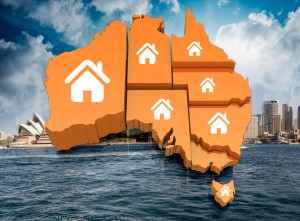Housing recovery gathers momentum through first month of spring, with national dwelling values up 0.9%.
The CoreLogic September home value index results saw the national index post the largest monthly gain since March 2017, largely driven by a strong rebound in Sydney and Melbourne where values were up 1.7% over the month. 
The housing market has made further progress towards a recovery, with CoreLogic’s national home value index recording the third consecutive month of gains, lifting the national value of housing by a cumulative 1.7% since the market found a floor in May 2019.
The month-on-month lift of 0.9% in national housing values was the largest monthly gain since March 2017.

Although housing values are now consistently tracking higher, at least at a macro-level, the national index remains 6.8% below the October 2017 peak, indicating that buyers still have some time to take advantage of improved housing affordability before values return to record highs.
The September gains were once again driven by stronger conditions emanating from Sydney and Melbourne where dwelling values increased by 1.7% over the month; Australia’s two largest cities have seen a rapid bounce-back in home values over the past two months, with Sydney up a cumulative 3.3% and Melbourne up 3.2% in August and September.
Housing values remain 11.9% below their July 2017 peak in Sydney and 7.9% below Melbourne’s November 2017 peak.
Brisbane (+0.1%) and Canberra (+1.0%) were the only other capital cities to record a rise in dwelling values over the month, while values held firm in Adelaide but fell in Hobart (-0.4%) and continued their long run of losses in Perth (-0.8%) and Darwin (-0.2%).

Most of the regional markets recorded a rise in September, with regional SA (-0.5%) and regional WA (-1.3%) the only ‘rest of state’ areas to record a drop in values.
The strong rebound in Sydney and Melbourne housing markets relative to other regions, can be attributed to a variety of factors.
While all regions are benefitting from low mortgage rates and improved access to credit, economic and demographic conditions in New South Wales and Victoria continue to outperform most areas of the country.
Population growth is higher, unemployment is lower and jobs growth is stronger, providing a solid platform for housing demand.

Another factor cited as driving the strength in Sydney and Melbourne property markets could be higher levels of investor participation.
The latest housing finance data from the ABS (to end of July) shows investors comprised 32% of mortgage demand across New South Wales and 26% of Victorian mortgage demand which is higher relative to any of the states or territories. 
Although markets outside of Sydney and Melbourne aren’t showing the same recovery trend, most areas have either seen a reduction in the rate of decline or are seeing a modest trajectory of growth as low mortgage rates and a slight loosening in credit policy support buyer demand.
CoreLogic’s stratified hedonic index shows that each of the broader valuation cohorts are on a recovery trend, however it’s the most expensive quarter of the market where values are rising the fastest.
The top quartile of capital city housing values recorded a 3.6% gain over the September quarter compared with a 1.4% rise across the broad middle of the market while conditions were flat across the lower quartile.


Across the product types, the prestige end of the unit sector has seen the highest capital gain over the quarter, with values up 3.8% compared with a 3.6% rise across the top quartile for houses.
The rapid recovery across higher valued properties makes sense considering this sector of the market recorded a more substantial correction.
Additionally, borrowing capacities have recently increased following the relaxation of serviceability rules from APRA which may be stoking demand across higher price points. 
While only four of the forty-six capital city sub-regions have recorded a rise in housing values over the twelve months ending September, the latest quarter has seen a substantial turn around in areas where values are now rising.
Thirty three of the capital city sub-regions recorded a rise in values over the quarter, led by Melbourne’s prestigious Inner East where values were up 5.9% and Sydney’s Inner West with a 5.2% gain.
These areas were also amongst the markets that recorded the largest correction during the market downturn; despite the recent upwards pressure on prices, values remain more than 10% below their 2017 peaks.
Four of the top five weakest capital city sub-regions over the September quarter were located in Perth; Mandurah recorded a 3.9% drop in housing values, taking the cumulative decline across this sub-region to -37.4% since peaking in December 2006.
Perth’s South West (-2.9%) and North East (-2.5%) recorded the second and third largest declines in dwelling values over the September quarter.
The regional sub-markets have generally shown better resilience to falling prices relative to the capitals. 
Across the forty-two sub- regions outside of the capital cities, seventeen regions recorded a rise, or stable conditions over the twelve months ending September 2019.
The Riverina region of NSW led the annual capital gains with a 4.5% gain, however values have started to slip lower across this market, down 1.9% over the past three months.
The Mackay/Isaac/Whitsunday region was the second best performing regional area, with values up 4.4% over the past twelve months, although home values remain almost 25% below their 2012 peak.
The quarterly results weren’t quite as strong, with thirteen of the forty- two sub-regions recording a gain in values over the September quarter.
There is evidence that many of the largest regional centres are starting to recover with Geelong (+1.3%), Illawarra (+1.0%) and Newcastle / Lake Macquarie (+0.5%) all recording a rise in value over the September quarter.
Some of the iconic coastal markets are also moving back into growth territory with values up across the Gold Coast (+1.0%), Sunshine Coast (+0.9%) and Richmond Tweed (+0.4%) over the quarter.

Nationally rents trended lower for the fourth straight month, down 0.1% over the month and 0.3% lower over the September quarter.
Five capital cities recorded a quarterly decline in rents (Sydney -1.0%, Melbourne -0.3%, Perth -0.4%, Darwin -0.2% and Canberra -1.1%) while only two capitals have recorded a drop in rents over the past twelve months (Sydney – 2.2% and Darwin -2.7%).
The weak trend in the performance of the rental market against rising home values has seen the recovery in rental yields take a U-turn. 
Gross rental yields are generally still higher relative to a year ago across most regions, but are trending lower across most areas, with the most rapid yield compression in Sydney (3.2%) and Melbourne (3.5%).
Although yields are trending lower, landlords are receiving a better rental return than they were when capital city gross yields reached a record low of 3.4% as values peaked in 2017.
Despite lower rental yields, with mortgage rates low and likely trending lower, the yield on residential property is looking increasingly attractive, especially when factoring in the total return which includes capital gain.
Fixed rate mortgage rates are generally around the 3.8% mark which is roughly equivalent to the gross rental yield across the combined capitals.
The improving prospects for capital gains and narrow spread between mortgage rates and rental yields is likely to see the housing market become increasingly attractive to investors.
Currently, investors comprise around a quarter of mortgage demand, well down from the recent record highs of 43% set in 2015 and below the long term average which shows investors typically comprise around one third of mortgage demand.

The September housing market results provide further confirmation the housing market recovery is in full swing across Sydney and Melbourne while the remaining capital city and regional areas are showing a mixed result.
Low mortgage rates, and the expectation that they will move lower, along with better affordability, a loosening in credit rules and improved housing sentiment, are all factors contributing to the rebound.
Strong economic and demographic conditions in Sydney and Melbourne help to explain the over performance in these markets despite housing affordability challenges in these areas.
A variety of other indicators outside of our hedonic index are pointing towards further strength in the housing market, including auction clearance rates which are continuing to track around the mid-to-high 70% range, with the results remaining high on larger volumes.
The correlation between the auction success rate and housing values is holding true, with the strength in auction markets providing a timely insight into the fit between buyer and seller pricing expectations.
Amidst a rise in buyer activity advertised stock levels are lower which is creating some urgency amongst buyers.
The number of listings across the capital cities is 10% lower than a year ago, and fresh listings being added to the market are 15% lower than a year ago.
As buyer activity rises, the lack of available stock could see a renewed sense of FOMO supporting further price growth. 
Clearly, mortgage demand is rising with the most recent housing finance data reporting a substantial lift in both owner occupier (+5.3% in July) and investor (+4.7% in July) housing finance commitments.
Although ABS data is only current to July, the number of mortgage related valuation events across CoreLogic platforms has been trending consistently higher, implying a further lift in housing credit through August and September.
Policy makers and regulators appear to be comfortable with the housing rebound to date.
Potentially improved housing values and activity will help to boost consumer attitudes and fuel spending as well as ease the downturn in residential construction activity.
However, household debt levels reached new record highs relative to their incomes over the June quarter, suggesting the sector is vulnerable to a shock or change in household circumstances.
from Property UpdateProperty Update https://propertyupdate.com.au/dwelling-values-have-a-spring-in-their-step-for-the-first-month-of-the-season/


No comments:
Post a Comment